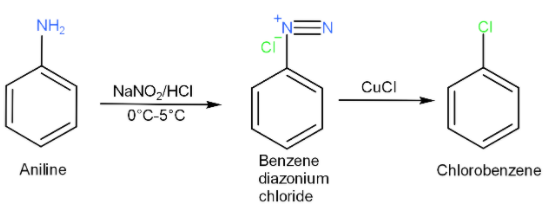Answer
64.8k+ views
Hint: Start by drawing the structure of the reactant. Think what kind of reactions aniline undergoes with the given reagents in the options. The product formed should not contain any other substituent on the ring except chlorine.
Complete step by step solution:
-Aniline is an aromatic amine. It is a base.
-Let’s have a look at the question. We need to prepare chlorobenzene from aniline. That means the amine group needs to be replaced by a chlorine group.
-We have studies that amine group can only be replaced after it has been converted to diazonium salt form, which is unstable. Direct halogenation of aniline will give rise to halogen derivatives of aniline.
-If HCl is added to aniline, then aniline being a base will abstract the proton and form anilinium chloride salt.
-When aniline is treated with nitrous acid, which is produced in situ by sodium nitrite and hydrochloric acid, at low temperature $\left( 0{}^\circ C-5{}^\circ C \right)$, then aniline is converted to a benzene diazonium salt. This reaction is known as diazotization.

-When a freshly prepared solution of benzene diazonium salt is treated with cuprous chloride (CuCl), it gives chlorobenzene. This reaction is known as Sandmeyer’s reaction.
-Therefore, chlorobenzene can be prepared by reacting aniline with nitrous acid followed by heating with cuprous chloride (CuCl).
Therefore, the correct option is (D).
Note: Chlorobenzene can also be prepared by treating benzene diazonium salt with copper powder and hydrochloric acid. This reaction is known as Gattermann reaction and has a better yield than Sandmeyer reaction. Remember in aromatic compounds electrophilic substitution reactions occur readily and therefore, direct halogenation will yield halo-substituted compounds.
Complete step by step solution:
-Aniline is an aromatic amine. It is a base.
-Let’s have a look at the question. We need to prepare chlorobenzene from aniline. That means the amine group needs to be replaced by a chlorine group.
-We have studies that amine group can only be replaced after it has been converted to diazonium salt form, which is unstable. Direct halogenation of aniline will give rise to halogen derivatives of aniline.
-If HCl is added to aniline, then aniline being a base will abstract the proton and form anilinium chloride salt.
-When aniline is treated with nitrous acid, which is produced in situ by sodium nitrite and hydrochloric acid, at low temperature $\left( 0{}^\circ C-5{}^\circ C \right)$, then aniline is converted to a benzene diazonium salt. This reaction is known as diazotization.

-When a freshly prepared solution of benzene diazonium salt is treated with cuprous chloride (CuCl), it gives chlorobenzene. This reaction is known as Sandmeyer’s reaction.
-Therefore, chlorobenzene can be prepared by reacting aniline with nitrous acid followed by heating with cuprous chloride (CuCl).
Therefore, the correct option is (D).
Note: Chlorobenzene can also be prepared by treating benzene diazonium salt with copper powder and hydrochloric acid. This reaction is known as Gattermann reaction and has a better yield than Sandmeyer reaction. Remember in aromatic compounds electrophilic substitution reactions occur readily and therefore, direct halogenation will yield halo-substituted compounds.
Recently Updated Pages
Write a composition in approximately 450 500 words class 10 english JEE_Main

Arrange the sentences P Q R between S1 and S5 such class 10 english JEE_Main

What is the common property of the oxides CONO and class 10 chemistry JEE_Main

What happens when dilute hydrochloric acid is added class 10 chemistry JEE_Main

If four points A63B 35C4 2 and Dx3x are given in such class 10 maths JEE_Main

The area of square inscribed in a circle of diameter class 10 maths JEE_Main



